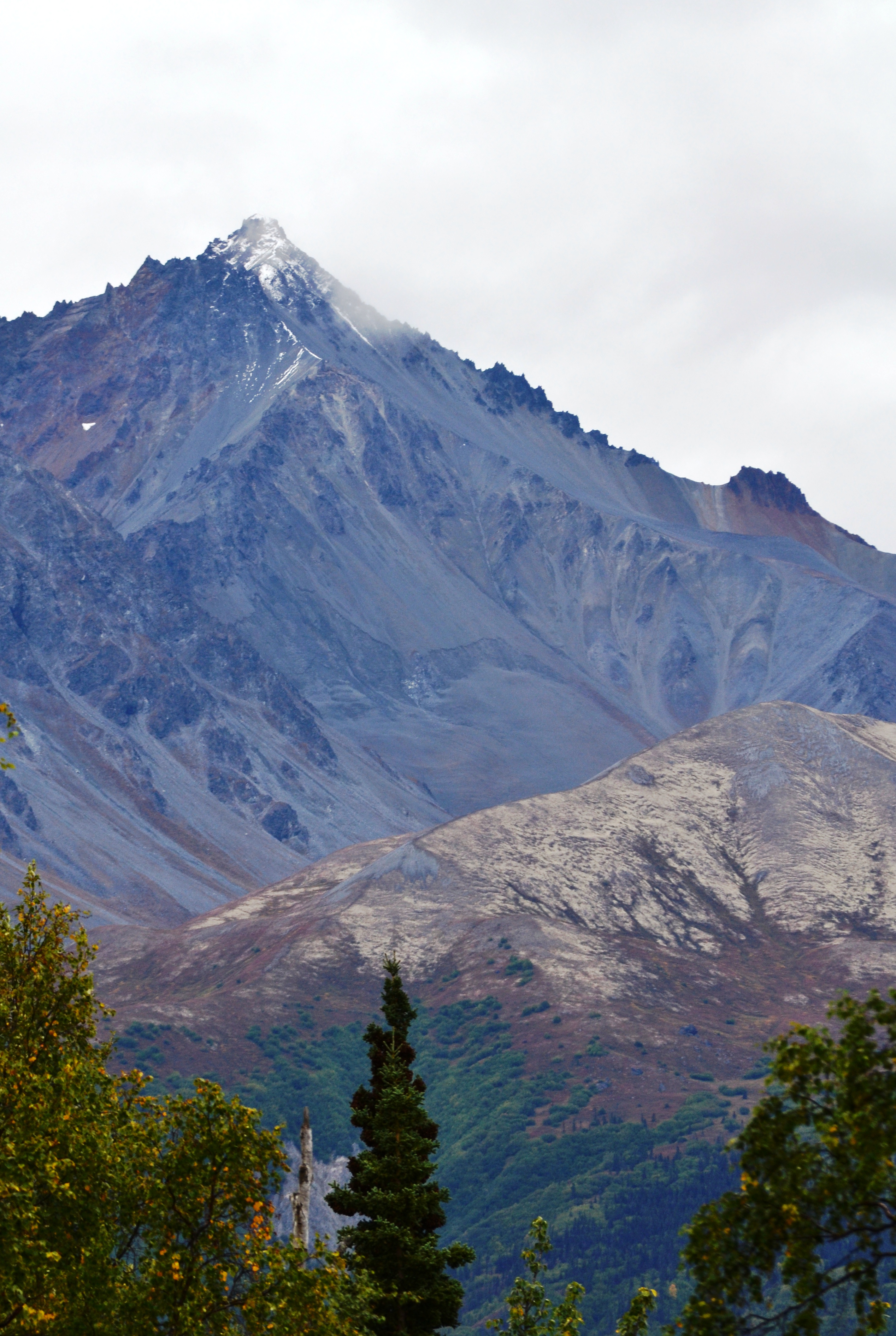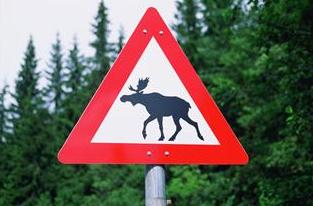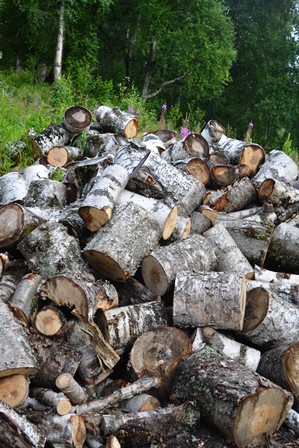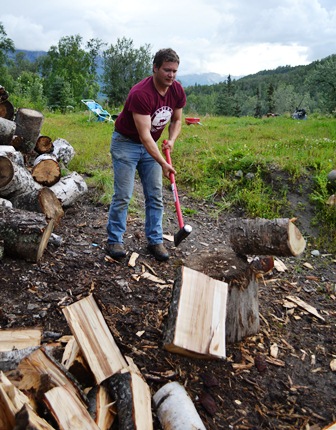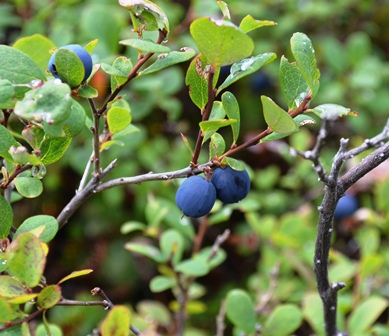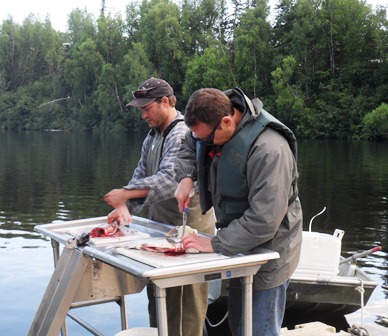Pickly peas, real and imagined
Part way through my novel, The Snow Child, a neighbor named Esther brings the main character a jar of pickled peas. We have some friends who make pickled peas, and they are delicious. But this fall, for the first time ever, I decided to make them myself.
My 4-year-old daughter and I went down to the garden and filled a gallon bucket with peas from the vines. Then, over the weekend, I convinced everyone in the family to help with the pickling process.
We gathered at our counter. Aurora picked the stems and leaves off the peas, I lined them up in the jars, Grace sprinkled in the dill, pepper flakes and cayenne (easy does it, per Mr. Baer), and Sam poured in the boiling apple cider and salt water. Then we put on the lids, lowered the jars into a giant pot and set them to boiling.
Half an hour later, we were forking steaming, spicy hot peas into our mouths. They were delicious, and potent. More of an appetizer to have along with some good bread or wheat crackers. Aurora turned them down with a wrinkle of her nose — she’s more of a meat-and-potatoes girl.
Last week, I tweeted about how I was going to make them:
Just harvested peas from the garden. Going to make my first batch of spicy pickled peas. Wish Esther was here to help. Life Imitating Art.
To which Chicago bookseller Nathan Dunbar, who has read an advanced reader copy of my novel, replied:
you could watch while Esther whizzed through it.
And I tweeted back:
Ha! She’d take over the kitchen! Imagining is actually making me feel a little dizzy, like when I look at an optical illusion.
It was such a wonderful, strange experience to be talking about this character, and her cooking, as if she were a real person instead of a creation of my imagination. And it made me wonder what Esther would think of our pickled peas.
Cheers!
Eowyn
A day in the life …
The other day my literary agent Jeff Kleinman called to discuss some marketing plans with me, and as we talked he asked, “Do you have another line ringing? Do you need to get that?”
“Umm, no,” I said. “That’s just Littlefoot.” As in my youngest daughter’s favorite dinosaur movie, The Land Before Time starring a longneck named Littlefoot.
This is the odd combination of life-changing and life-staying-exactly-the-same qualities of having my first novel being published. Sometimes I find the dichotomy amusing, other times a little jarring, and always interesting.
On Friday I told you my husband Sam had gotten a moose. After I sent my letter off to you, I put on my hunting pants and rubber boots, rain coat and work gloves, and met Sam at the bottom of the mountain. For the next four or so hours, he and I loaded hind quarters and front quarters, ribs and heart, into our backpacks and carried the meat down through birch meadows and alder thickets to the road. Sometimes this is a two- or even three-day job, but this year we were fortunate — the moose was fairly close to home.
 It was a beautiful afternoon. Along the mountains the leaves were turning, the air crisp and full of the scent of autumn berries. I managed to stumble only a few times with the heavy pack. Sam and I joked as we worked that this is our idea of a date — packing moose meat.
It was a beautiful afternoon. Along the mountains the leaves were turning, the air crisp and full of the scent of autumn berries. I managed to stumble only a few times with the heavy pack. Sam and I joked as we worked that this is our idea of a date — packing moose meat.
At 3 p.m., we hurried to the pickup truck with the last of the meat. I rushed home, quickly cleaned up and changed, and headed to my evening shift at Fireside Books. I was 15 minutes late, but by 5 p.m. I was straightening shelves and helping customers find copies of The Help and Franny K. Stein.
Later, when I printed out the bestseller list for the week, I was excited to see that my agent, Jeff, had another one of the books he represents appearing on the list — The Eighty-Dollar Champion: Snowman, the Horse That Inspired a Nation. I sent him a quick email to say congratulations, then went back to arranging the bestseller display.
When I got home that evening, Sam and I fried up some moose heart and ate it with garlic, onions, and mashed potatoes for dinner. Grateful to have meat for the winter, we toasted with a couple of glasses of red wine. Somehow I had managed to navigate through three separate lives in the course of one day. It left me a little worn out and entirely content.
Cheers!
Eowyn
P.S. Just a quick reminder — tomorrow, Tuesday Sept. 6, at 8 p.m. ET you can join me on twitter.com for #BiblioChat, where I’ll answer questions and discuss The Snow Child and my work as a bookseller and writer in Alaska. In preparation for the chat, Biblio-Files blogger Kelly Kegans is giving a sneak peek at the first chapter of The Snow Child on her blog biblio-files.com.
Gone packin’
I just got the phone call — Sam got a moose this morning. We’ll be spending the day hauling the meat down the mountain, through the forest, and back to our home using backpacks. It’s an incredible amount of work, but it will provide our entire meat supply for the upcoming year. As my dad once said to me when he called to tell me he had a moose down and needed help packing — It’s time to kick off the Birkenstocks and put on the hiking boots!
Cheers!
Eowyn
Autumn’s arrival
The other day as I drove home from work, I caught a flash of gold in the passing birch trees. It could have been mistaken for a single, dying branch, but it was not alone. By the time I neared our dirt road, just slightly north and at a higher elevation than town, most of the trees had been touched with yellow and orange.
This is how it arrives. Quietly. Gently. There is a chill in the air when I go outside to close up the hen house for the night. The cranberries have ripened bright red on the hillside. Fireweed has bloomed into downy seeds. The garden rows hold mostly vacant cabbage stalks and picked-over pea vines. And finally, after a summer of endless days, nightfall now brings complete darkness.
A few mornings ago, Mr. Baer called to tell me he had shot a spike-fork moose in the neighborhood. It was opening day. They will let the meat hang in their root cellar for a few days before they begin to butcher. On the highway, pickup trucks haul the evidence of other successful hunts — caribou antlers and full game bags. We hope to be so fortunate when we go sheep and moose hunting these next few weeks.
This time of year is a frenzy of preparation. We split wood, pick berries, hunt, and harvest the garden vegetables. As the days grow shorter, time seems to slip by more quickly.
Last night my daughter ran in from the back porch and announced, “It smells like snow outside, Mommy.” In truth, the snow won’t come for another six weeks or so. But it is, somehow, already in the air.
Autumn touches me with a sweet kind of melancholy. It’s something akin to the precise moment when the setting sun casts a golden light across the land, just before it gives way to cool twilight.
The beauty comes, in part, from its fleeting nature.
Cheers!
Eowyn
Getting ready for, dare I say, … winter
Dear autumn reader,
With the help of some good friends (Thanks Adam and Kira!), we piled this birch in our yard earlier this summer …
We’ve spent the past week doing a lot of this …
And this …
So we’ll have plenty of this …
And won’t have to dress like this all the time …
Cheers!
Eowyn
Hateful things
Dear goodhearted reader,
My letters, I’m afraid, too often describe only the unique beauty and wondrous wilds of Alaska. Perhaps I wander off on tangents of romanticism or present an idealized version of my home.
Years ago in a graduate creative writing course, I discovered Sei Shonagon’s Pillow Book. It’s a 10th century Japanese equivalent of the memoir, but what stayed with me is her amusing, telling list of hateful things. I highly recommend it.
In honor of truthfulness and in respectful imitation of Sei Shonagon, here is my list of hateful things:
* One forgets to bring in the liquid laundry detergent from the car, so that when it is time to launder one’s eight loads of clothes at the laundromat, it is a solid chunk of frozen soap and impossible to pour.
* The flock of ravens that follows one’s pickup truck around town because of the collection of trapping bait in the back. To be the center of such an embarrassing scene — hateful!
* The 35th straight day of constant, grating, silt-laden Matanuska wind that rips one’s hat off one’s head and blows plastic shopping bags into the trees. It is quite unpleasant.
* January. Frozen, dark, gray, holiday-less January.
* One makes the long drive home from work behind a pickup truck pulling a trailer full of four-wheelers at an agonizingly slow pace, only to have the driver launch to illegal speeds once a passing lane becomes available. Such charmless, detestable behavior!
* Bumper stickers on Alaskan automobiles that say “I Hate Snow.”
* One stands, overheated and exhausted in winter boots and coat, in the crowded line at the post office for 45 long minutes to hand a slip to an overworked, quarrelsome employee, only to receive in exchange … the annual Cabela’s sporting goods catalog.
* January.
* One spends the entire day making homemade eggnog, handwhipping egg whites from one’s own chickens and pouring in lavishly expensive brandy, but when one sets it on the back porch to keep chilled until the guests have arrived, one’s dog laps up half the bowl. One is forced to confess the embarrassing mishap to the guests, who choose to drink the last of the eggnog anyway.
* The two hours required to inflate the tires and start the engine in the rusty plow truck in order to spend half an hour plowing the driveway before needing to re-inflate the tires. (This hateful thing contributed by my husband Sam.)
* Daylight savings in a place that has 4 hours of daylight on winter days and 20 hours on summer days.
* Rocks in an otherwise perfect sledding hill. Hateful things!
* One calls to order a product, a pair of socks or a dish towel, only to be told that it will cost double the advertised price because of the cost of shipping to Alaska, which the telephone associate is not sure is even part of the United States. What foolishness!
* A legal, spike-horned bull moose standing in one’s garden, chomping one’s precious, tender cabbages and broccoli, three days before the opening of hunting season. One is tempted to shoot the thing anyways, but then one remembers she is married to an Alaska Department of Fish and Game biologist with a badge, so refrains.
* One wakens to howling wind, blowing snow, and icy roads, only to learn that school has NOT been canceled. (This hateful thing contributed by my eldest daughter.)
* A cold and rainy summer that allows for only one dip in the neighborhood lake.
* January.
* One sits quietly minding one’s own business on an airplane only to have the nearby seatmate strike up a conversation and, upon learning that one is from Alaska, ask if one knows a certain famous/infamous never-to-be-named-here Alaskan, and if one admires/hates this Alaskan. Why must this conversation ever occur?
* A broken car heater that requires one to wear mittens, fur hat, coat, scarf, and snowsuit and to scrape the ice from the inside of the windshield as one is driving to town. Most hateful!
* One plans a sledding party weeks in advance, only to have it unexpectedly rain in the middle of winter and turn the hill to slush.
* The constant complaining of people who have lived in Alaska for 20 years but have always wanted to live somewhere else. How tiresome!
Cheers!
Eowyn
P.S. My favorite blogger The Rejectionist did a similarly inspired post a while back. I highly recommend it, too.
And we’ll go together to pick wild berries
Dear secret reader,
Pssst. I know a place where we can find blueberries. Fat, ripe, wild blueberries so thick on the bush that you can grab handfuls at a time. But first you have to hold up your right hand and solemnly swear on your neighbor’s blueberry pie that you will never reveal the location. No matter who asks or how they tempt or torture you, this secret must die with you. Really? Really.
You’ll need buckets. Gallon plastic containers with handles, the kind you can buy filled with ice cream at the super market, are perfect. Bring a few, just in case we get really lucky.
Dark thunder clouds are gathering at the mountains. It’s sunny now, but there will be a downpour later, and then more sun. So wear your rubber boots and bring your rain gear. Grab the mosquito repellent, a few snacks for the kids and the dogs, and a bottle of water.
We’ll drive a little ways, and then we’ll hike a little ways. We might see some grouse or ptarmigan. An owl might perch in a spruce branch over your head. We’ll probably see bear or moose tracks in the muddy trail. And eventually we’ll find ourselves at the edge of alpine tundra, where the spruce and birch forest gives way to Labrador tea bushes, lichen covered rocks, and knee-high berry bushes.
The lowbush cranberries aren’t ripe yet, so don’t pick them. And the blackish crow berries are edible, but not very good, so let’s leave those behind. Here — these are the ones you want. You see? The fat, sweet-tart blueberries.
When you first start dropping them into the bucket, they’ll make a loud “plunk,” but then, as your bucket fills, they will land silently on the heap of other berries. Your bucket will get heavy, and you’ll become completely absorbed in your task. You’ll skip over the skimpier bushes, the berries that are small or oddly shaped. You know what you want now. That luscious dark blue hanging heavily from the branch.
Tonight we’ll spread the berries on cookie sheets and put them in the chest freezer. Once they’re firm, we’ll transfer them into gallon plastic bags and put them back in the freezer.
When you climb, tired and content, into bed tonight, you’ll close your eyes and see the tundra, the bushes, one berry after another dropped into the bucket as you drift off to sleep.
Come early winter, when you’re yearning for those sunshiny days on the tundra when the cinquefoil and saxifrage bloomed in the marsh and the owl flew off into the trees, you and I together will make some blueberry jam or a whipped-cream topped pie, and we’ll pretend it’s August again.
 But for now, lose yourself in the bushes. Fill your bucket, handful after handful.
But for now, lose yourself in the bushes. Fill your bucket, handful after handful.
Cheers!
Eowyn
P.S. Thanks to Mr. Baer and Chickaloon Jenny! 🙂
Alaska fish speak
Dear reader, near or far,
You might have noticed in my P.S. on Friday that I mentioned the “humped-back pink” on the end of my fishing line. And, if you read the comments from my fellow Alaskans Jim Novak and Mr. Baer, you saw it described as a “trophy.” Unfortunately, sarcasm doesn’t have its own font. If it did, theirs would have been in bold
Pink salmon, also known as humpies, are a lesser fish for someone angling after a trophy, or dinner. In Alaska, we have five different types of salmon, and they are all not created equal.
My husband is a fishery biologist who manages salmon in our area for the Alaska Department of Fish and Game. He could give you all the Latin fish names, complicated run data, detailed regulations, and much more. But I have decided to give you my own glossary of Alaskan salmon.
* Kings, also known as chinooks. They have the name for a reason. The biggest ever caught weighed nearly 98 pounds. Kings are enormous and delicious, especially grilled the same day they are caught. Despite all of this, I personally find king fishing frustrating. It means getting up at 3 a.m., traveling by car and/or boat for hours, only to fish beside 75 other people who are winging hooks past your ear. You can stare all day at the end of your line and never get a single bite. The next morning, your husband can go to the same spot, while you stay in bed with the pillow over your head, and he’ll reel in a 45 pounder on the first cast. Not that I’m bitter.
* Reds, also known as sockeye. One of the most prized salmon. You can buy Alaskan sockeye fillets in markets around the world, for roughly the cost of your arm and leg. Reds aren’t huge, usually around 8 pounds, but their meat is bright red, flavorful and my personal favorite to eat. Sockeyes aren’t easy to catch — they don’t bite hooks. A bit inconvenient when you’re fishing for them. You can get them on hook and line by miraculously sliding the line through their open mouths and catching them unawares on the hook. It’s about as easy as it sounds. We get sockeyes with dipnets during a season opened specifically to help Alaskans fill their freezers.
* Pinks, or humpies. This is the so called “trophy” fish in last week’s photo. While commercial fishing relies heavily on pink salmon, they are considered junk fish for many anglers. When we catch them, we release them. They are small and not particularly tasty because their flesh tends to be paler and mushier than kings or sockeyes. The irony — on odd years like 2011 they are also the most abundant salmon in our part of Alaska. Inevitably when you are trying to catch a coho, you will instead reel in seven pinks. Hence last week’s photo.
* Chums, or dogs. These are the most disparaged salmon. Locally they are called “dogs.” Maybe it’s because they are so ugly, with their splotchy skin and oversized teeth, or maybe it’s because their flesh is so bland, it has traditionally been dried and used to feed dog teams through the winter. Enough said.
* Cohos, or silvers. This is my favorite salmon to catch, partly for the thrill of it. They come bright and silvery into the rivers, and they are feisty as they splash and roll in the water. They often weigh around 10 pounds, sometimes larger. They are wonderful to eat jarred or filleted.
And so, to make up for my photo last week, here I am with two of the coho salmon I caught over the weekend.
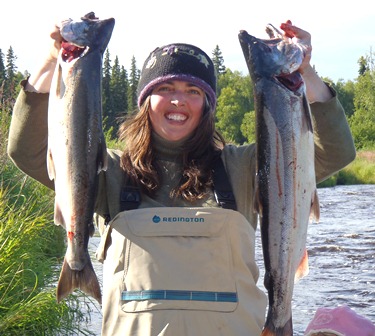 Yes, Mr. Novak and Mr. Baer. They really are cohos!
Yes, Mr. Novak and Mr. Baer. They really are cohos!
Cheers!
Eowyn
Gone fishin’
Be back Monday, hopefully with fresh salmon for the grill. Have a great weekend, dear reader.
P.S. Yes, Mr. Baer. That IS a hump-backed pink on the end of my line. I let it go — I promise.
The truth about adventure
Dear kind reader,
Lest you get the impression after my recent letters that I am some kind of gun-slinging, calmly perceptive and quick thinking outdoor superhero, I feel the need to shatter the illusion. This is the advantage of telling my own stories — I can highlight the parts that seem the most interesting, the most exciting, and the most flattering to myself. I can leave out the embarrassing missteps, the silly goofs and bad choices.
But it’s time for me to come clean.
When my husband and I floated the Copper River last month, we launched the raft into beautiful, sunny skies. The sun shone out of the blue and glinted off the water. The air, cooled by glaciers and heated by the sun, blew a powerful wind up the river. This breeze kept me comfortable even as I basked in the sun. Sam rowed, and I watched the mountains and trees slip by. I snapped pictures. I smiled. I talked. The world seemed good and sunny.
The next morning I woke up in the tent with a fat lower lip. Or “fat-ter” as my husband kindly pointed out. Over the years I have been both teased and envied for my genetically acquired full lips. But this morning, I knew something was not right. I felt as if someone had punched me in the mouth, but I had no recollection of any injury.
We got in the raft and floated off into the sun, wind, and water once again. It crossed my mind that my face was getting a bit burned, and that my lip was increasingly uncomfortable, but I was still mystified by the situation. Could I have suddenly developed an allergy?
That night, it finally dawned on me. I had sunburned my lower lip. I was mortified. My lips were so freakishly large that they were an extra extremity that could, unto themselves, be sunburned. All the teases and taunts of my childhood came rushing back to me.
And the next morning when I woke up, I looked and felt like a street boxer, or a mutated fish. My lower lip was as fat as a hot dog, and had the same unpleasant sheen as one glistening on the grill. It was so swollen I had difficulty swallowing or chewing or drinking. And all I wanted in the world was to shove my face into a glacier. In our emergency kit we had a plastic ice pack, the type where you burst the bubble inside the packet and it turns cold. I took several ibuprofen and held the ice pack to my lips. Neither made any noticeable difference.
“There is no way I can go into Cordova like this,” I mumbled to Sam. “I look hideous.” I spent the next hours with my long-underwear shirt pulled up over my face like a bank robber. Even though we didn’t see another soul on the river for days, I didn’t want to risk scaring off even the wildlife.
Finally we floated past a snow field. I jumped to shore and packed my canteen with snow. For the rest of the day while we floated, I pressed my mouth into the snow.
Thankfully, by the time we met up with our two daughters and my mom near Cordova, my lip had returned to somewhat normal size, although it was still painful. I vowed there and then to never go on a trip without sunscreen chapstick.
But this isn’t the end of my tale of ineptitude and woe. As we were driving back from Cordova, we hit a stretch of highway where permafrost has caused great heaves and buckles in the road. I was casually rubbing my eye when Sam hit one of these bumps, and I jammed my thumb into my eye. It hurt, but not too terribly. But when I turned to Sam, he squinted at me and frowned. “Your eye …” he said. I looked in the truck mirror to discover a huge blood spot in the white of my eye.
Now I really did look like a losing boxer. I would have liked to tell everyone that I had survived a fight with a bear. Instead I confessed — my lips are so big they got sunburned and my hands so clumsy I thumbed myself in the eye.
So there’s a snapshot of my less graceful, less competent side. But, for all our good, I’m not including an actual snapshot. No one needs to see that.
Cheers!
Eowyn


